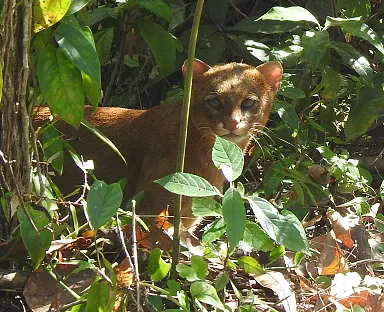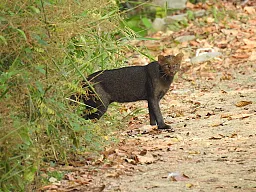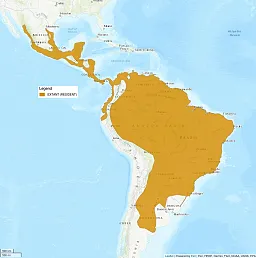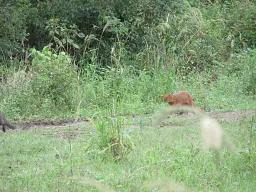
Jaguarundi photo © Josiah Townsend · some rights reserved
Jaguarundi
Species Facts
Although the jaguarundi is the most widely distributed and commonly seen cat in Central and South America, its biology and behavior largely remain a mystery.
- Scientific Designation: Herpailurus yaguarondi
- Endangered Status: Least Concern (LC)
- Lifespan: Up to 15 years
- Weight: 2-9 kg
- Body Length: 51-77 cm
- Shoulder Height: 25-35 cm
- Tail Length: 28-61 cm
Profile
This cat has a very unusual appearance. In fact, it hardly looks like a cat at all. It has an elongated, low-slung body that is reminiscent of a marten. It is dark-colored with short legs, a long and slender body, and a relatively long tail. The jaguarundi has a small, slim head with short, rounded, widely separated ears. It is the least marked of all the small cats, with the fur being mainly uniform in color.
It differs from most other South American cats, but shows some behavioral similarities with the puma. While the other small South American cats have 36 chromosomes, the jaguarundi has 38, the same number as Old World cats. In fact, DNA techniques suggest that the jaguarundi is more closely related to the cheetah and the puma, rather than to other South American cats.

Jaguarundi photo © Rosabel Miro · some rights reserved
Diet
The species has been observed moving about and hunting at all times of the day and night. The jaguarundi usually preys on small animals less than 1 kilogram, such as rodents, birds, and reptiles. However, the cat is an opportunistic predator and will take the most abundant and easily catchable prey.

Species Distribution
The jaguarundi ranges from southern Texas through the coastal lowlands of Mexico, southward throughout Central America. Within its range, the jaguarundi lives in elevations ranging from sea level to 3200 meters. A solitary predator, it lives in a wide variety of habitats, from semiarid thorn forest to wet grasslands. However, it is usually observed in areas of dense cover mixed with openings and edges.
Distribution map courtesy of IUCN (International Union for Conservation of Nature), compiled in 2015.

Jaguarundi photo © aguaraguazu · some rights reserved
Threats to the Jaguarundi
The jaguarundi has the lowest conservation priority ranking (Least Concern [LC]) by the International Union for Conservation of Nature (IUCN), and is considered to be relatively common. This is due to the fact that jaguarundi pelts have little commercial value, and the species is not subjected to the same intense hunting pressure as the small spotted cats. However, in Central America and North America, the jaguarundi is listed on appendix I of the Convention on International Trade in Endangered Species (CITES).
Want to help us research and conserve this species?
Felidae Conservation Fund helps researchers around the world study and protect felids of all sizes.
Make sure you write a comment with "Jaguarundi" so we can designate 100% of your donation to go to protecting this species.
Do You Have 2-4 Hours A Month To Preserve Your Local Ecosystem?
Our volunteers are the driving force behind making true change in ecosystem health and wild cat conservation. Some like to volunteer in the field, others help us maintain our online presence, and some work with events. With just a few hours a month, you can make a difference, too.
Make A Difference Right Now
As a 501(c)3 nonprofit, our work is only possible because of generous donors like you.
More than 90% of your donation will go directly to our groundbreaking research, outreach, and education programs.
This is where true change starts. If you’d like to be a part of it, make a donation to Felidae Conservation Fund today:
Or,
